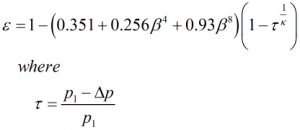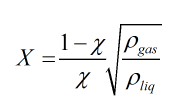C311 – ISO 5167/TR 12748 Wet Gas Orifice Flow Calculation
Description
This calculates the corrected dry gas mass flow rate for orifice plate metering systems handling a wet gas flow. The formulae from ISO TR12748 are applied to the ISO 5167 calculated dry gas mass flow rate in order to correct the over reading that occurs when a wet gas is encountered.
References
ISO TR 12748:2015 – Natural Gas – Wet gas flow measurement in natural gas operations
Horizontally Installed Orifice Plate Meter Response to Wet Gas Flows – A.Hall, B.Priddy, R.Steven, G.Stobie (2011)
ISO 5167: Measurement of fluid flow by means of pressure differential devices inserted in circular cross-section conduits running full
ISO TR9464: Guidelines for the use of ISO 5167
Kelton calculation reference C311
FLOCALC calculation reference F072
Kelton calculation C270 – ISO 5167 Orifice Mass Flow Calculation
FLOCALC calculation F037: Upstream Density Calculation
Options
Tapping Type
- Flange
- D/D2
- Corner
This option group allows the selection of the tapping type used for the pressure measurements on the orifice plate system.
Expansibility factor
- User entered
- Calculated
This option give the choice of calculating expansibility or entering a keypad value.
Temperature
- Upstream
- Downstream
This option allows selection of where the temperature is measured, upstream of the orifice plate meter or downstream where the flow has fully recovered.
Joule-Thomson Coefficient
- User entered
- Calculated
This option allows the Joule-Thomson coefficient to be entered if the value is known or calculated by Reader-Harris’ simplified equation (ISO TR9494:2008) if otherwise.
Density
- Upstream
- Downstream
This option group allows selection where the density measurement is taken, upstream of the orifice plate or downstream at pressure, p2, and temperature T3.
Density Referral
- Isentropic
- Isenthalpic
This option group will appear if the downstream density option is selected. It allows a choice of whether density is corrected to upstream conditions using an isentropic or isenthalpic (PTZ) correction as shown in F037.
Liquid
- Hydrocarbon
- Water
- Water-hydrocarbon mixture
This option is used to specify the nature of the liquid within the flow.
Liquid density
- User entered
- Calculated
This option is used to select whether to input the liquid density or calculate it from known water and hydrocarbon liquid densities as well as water to liquid mass ratio.
Chisholm exponent (n)
- User entered
- Calculated
This option is used to specify whether the n value used is calculated as per the standard or user entered. Note n has a (editable) default of 0.25 if user entered is selected as this is the value from Chisholm’s original correlation.
Calculation
Uncorrected Mass Flow Rate
The uncorrected mass flow rate is calculated by:

| Where | ||
|---|---|---|
| Cd | = | Coefficient of discharge |
| β | = | Diameter ratio |
| ε | = | Expansibility factor |
| d | = | Orifice bore |
| Δp | = | Differential pressure |
| ρ1 | = | Upstream density |
Coefficient of discharge
The Reader-Harris/Gallagher equation is used to calculate dry gas discharge coefficient.
Expansibility Factor
The expansibility factor is calculated by:

Pressure Loss
The permanent pressure loss is calculated by:

Temperature Referral
Upstream temperature is calculated by:

| Where | ||
|---|---|---|
| p1 | = | Upstream pressure |
| κ | = | Isentropic exponent |
| T3 | = | Recovery point temperature |
| Δω | = | Permanent pressure loss |
| μJT | = | Joule-Thomson coefficient |
0
Liquid density
If liquid density is calculated it done by:

| Where | ||
|---|---|---|
| WLMR | = | Water liquid mass ratio |
| ρw | = | Density of water |
| ρhcl | = | Density of hydrocarbon liquid |
Lockhart-Martinelli parameter
The Lockhart-Martinelli parameter is calculated by:

| Where | ||
|---|---|---|
| χ | = | Gas mass fraction |
| ρliq | = | Density of the liquid |
| ρgas | = | Density of the gas |
Chisholm coefficient
The Chisholm coefficient is calculated by:

| Where | ||
|---|---|---|
| n | = | Chisholm exponent |
| ρliq | = | Density of the liquid |
| ρgas | = | Density of the gas |
Chisholm exponent
If the Chisholm exponent is calculated it is done by:

![]()
| Where | ||
|---|---|---|
| Frg | = | Gas Froude number |
Wet gas over reading
The over reading due to the wet gas is calculated by:

| Where | ||
|---|---|---|
| X | = | Lockhart-Martinelli parameter |
| CCh | = | Chisholm coefficient |
